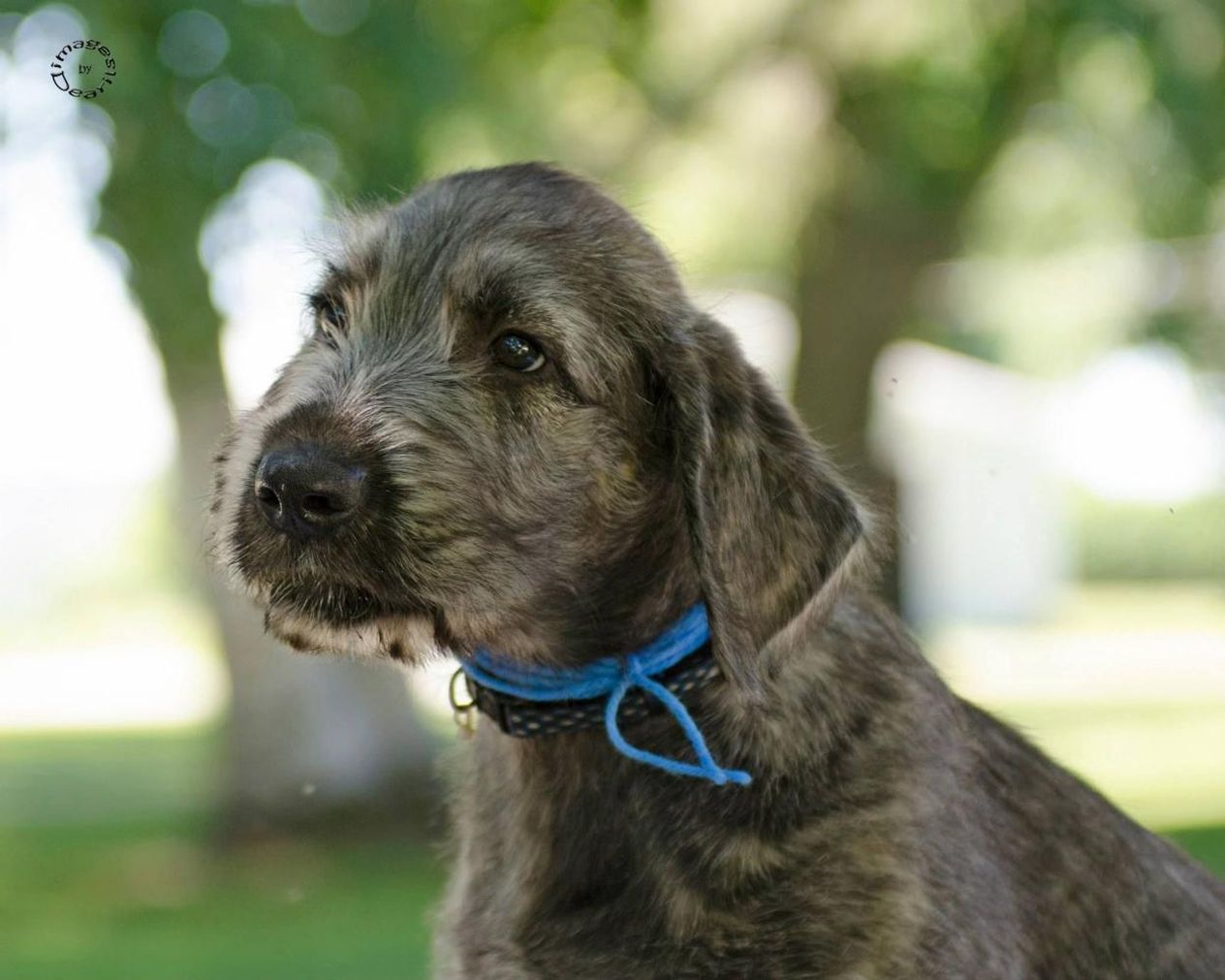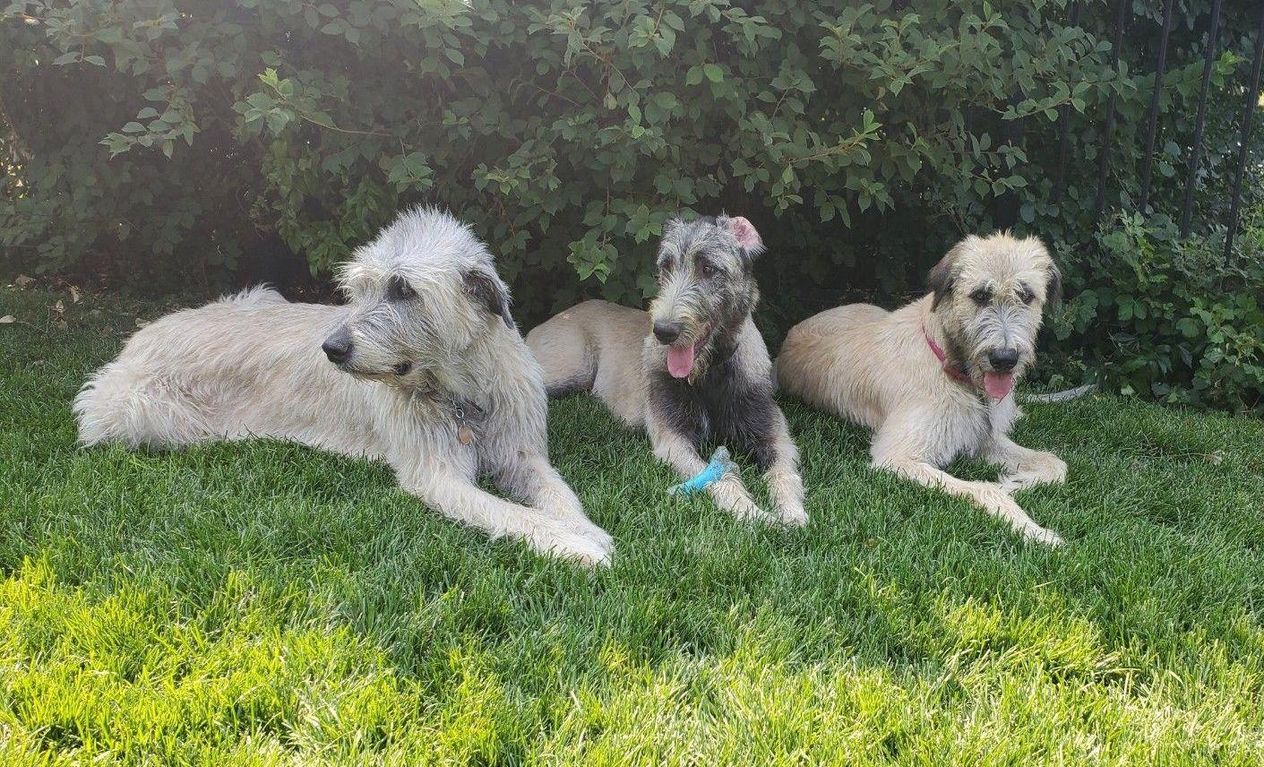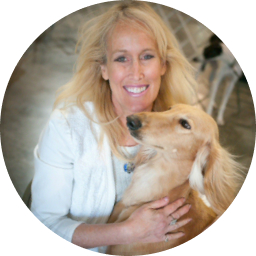Get to know
Irish Wolfhounds

Veterinarian reviewed
One of the tallest and calmest of dogs.
Browse available puppies
Connect with reputable breeders to find the dog of your dreams
At a glance
Low Energy
Energy level
2/5
Low Maintenance
Grooming
3/5
Extra large; at least 105 pounds for females, and 120 for males
Size
Calm, easy-going, quiet
Temperament
6-8 years
Lifespan
Average Trainability
Training
3/5
Quiet
Barking
1/5
At a glance
Energy level
Low Energy
Grooming
Low Maintenance
Size
Extra large; at least 105 pounds for females, and 120 for males
Temperament
Calm, easy-going, quiet
Lifespan
6-8 years
Training
Average Trainability
Barking
Quiet
Why people love the breed
The Irish Wolfhound looks commanding, but in reality, is a pushover.
Appearance
The Irish Wolfhound resembles a super-sized rough-coated Greyhound, built for both speed and strength.
Grooming
While grooming is pretty simple, there’s still a lot of dog that needs to be covered.
Westover Wolfhounds
Breed temperament and characteristics
Irish Wolfhounds define cool and calm. That is, unless there’s something to chase.
Exercise
Don’t let that laid-back demeanor fool you. Although they’re not hopping up and down, they still need to stretch their legs.
Boondock Irish Wolfhounds
Training
Irish Wolfhounds aren’t known for their obedience prowess, but they can and should still learn the basics.
Diet and nutrition
Prepare to have a large food bill. Irish Wolfhounds eat a lot of food.
Mt Carmel Irish Wolfhounds
Health issues
Like all giant dogs, Irish Wolfhounds have some health concerns that moderately sized dogs don’t.
Lifespan: 6 to 8 years.
Dilated cardiomyopathy
When the heart muscle becomes thinner and weaker, leading to a larger heart as the walls expand due to the pressure from the blood inside the heart, is a problem in the breed. Echocardiograms performed by a veterinary cardiologist or radiologist can detect this condition and should be performed on any Irish Wolfhound destined to be a parent.
Gastric dilatation-volvulus (GDV)
A life-threatening sudden twisting of the stomach. It is an emergency that can be fatal if not treated immediately. Irish Wolfhounds with a first degree relative (parent or sibling) that have experienced GDV are more likely to develop the condition.
Osteochondritis Dissecans (OCD)
An abnormality of cartilage development causing an inflammatory condition when the disease's cartilage separates from the underlying bone, can occur in large breed puppies, especially if not eating an appropriately formulated large breed puppy food.
Elbow dysplasia
When there is abnormal growth or development of the elbow joint. This condition is assessed by radiographs (x-rays) which are evaluated by a veterinary radiologist.
Osteosarcoma
This is a malignant form of bone cancer, which occurs at a higher rate in this breed.
Other health issues
Liver shunts and elbow hygromas.
History
The Irish Wolfhound has lived beside royalty for most of its existence.
About the author
Canine specialist, Caroline Coile, Ph.D., is the author of 34 dog books, including the top-selling Barron's Encyclopedia of Dog Breeds. She’s written thousands of magazine and web articles about dogs. She specializes in canine science, health, breeds and competitions. Caroline has won 20 national dog-writing awards, and was a 2015 Inductee into the Dog Writers Association of America Hall of Fame.
Veterinarian reviewed
Dr. Nate Ritter, DVM is the Veterinary Medical Director at Good Dog. He earned his Bachelor of Science in Biology from Lafayette College and his Doctor of Veterinary Medicine degree from Virginia-Maryland College of Veterinary Medicine. He is a member of the American Veterinary Medical Association, New York State Veterinary Medical Society, the Veterinary Medical Association of New York City, and the Society for Theriogenology. Additionally, he is a USDA-accredited veterinarian.
Breed Scorecard
Characteristics and temperament
Affectionate with family
3
Watchdog level
2
Playfulness
1
Adaptability
4
Social needs
3
Temperament
Calm, easy-going, quiet
Intelligence
3
Good with other dogs
4
Good with cats or other pets
3
Friendly with strangers
4
Good as a service dog
2
Good for apartments
2
Barking level
1
Appearance
Height
30-34"
Size
Extra large; at least 105 pounds for females, and 120 for males
Colors
Black, Blue, Brindle, Cream, Gray, Red, Gray and brindle, Red and brindle, Silver, White, Red wheaten, Wheaten, Wheaten and brindle
Coat texture
Harsh, wiry
Coat length
Medium
Training
Trainability
3
Exercise
Exercise needs
2
Exercise time
One hour daily
Mental exercise needs
2
Favorite activities
Lure coursing, hiking
Grooming
Grooming needs
3
Brushing frequency
Weekly
Needs professional grooming?
No
Drooling level
3
Health issues
Dilated cardiomyopathy
Gastric dilatation-volvulus (GDV)
Osteochondritis Dissecans (OCD)
Elbow dysplasia
Osteosarcoma
Other health issues
Other
Bred for
Running down wolves
Country of origin
Ireland
Popularity level
3
FAQs
On Good Dog, you can search for Irish Wolfhound puppies or dogs in rescues and shelters. Adopting an Irish Wolfhound from a shelter or rescue is generally less expensive than buying a puppy from a breeder with ethical practices. Across the United States, there are dedicated rescues that specialize in specific breeds and may even help transport an Irish Wolfhound dog to you from another part of the country. Although it can be more cost-effective, adopting the exact breed you're looking for is typically more difficult than working with a responsible breeder. Learn more about adopting a dog from a shelter or rescue.
Prices for Irish Wolfhound puppies for sale vary by breeder and individual puppy. On Good Dog today, Irish Wolfhound puppies are typically around $3,120. Because all breeding programs are different, you may find dogs for sale outside that price range.
Not in terms of grooming or exercise, but they do require a lot of space just to live in, as well as a higher food, veterinary, and boarding bill.
This big dog is larger than the typical wolf, both in height and weight.
This is a point of dispute. Although the Irish Wolfhound was long known as the tallest breed, the dogs that have held the records as world’s tallest dog have mostly been Great Danes. In addition, Great Danes are slightly stockier dogs. So while both are very tall and very heavy, the Great Dane is on average a bit larger.



